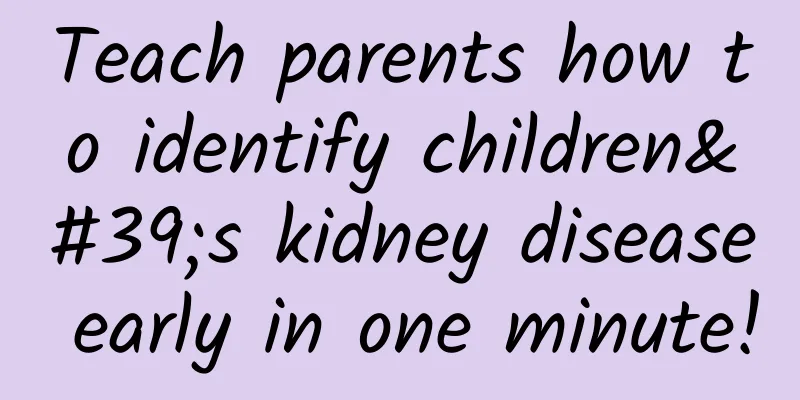Teach parents how to identify children's kidney disease early in one minute!

|
In recent years, the incidence of kidney disease in children has increased year by year. This disease not only damages the renal function of children, but also causes complications such as growth restriction and cardiovascular disease. In adulthood, there is a risk of developing end-stage renal disease, which can be life-threatening in severe cases. Kidney disease lacks obvious clinical symptoms in the early stages, and children do not feel pain or itching, so it is easy to be ignored. In addition, there are many types of diseases, and it is difficult to diagnose and classify them, making it difficult to make a reasonable judgment. If children's kidney disease is not diagnosed and treated in time, it may gradually develop into chronic renal failure. Once it reaches the end stage, renal replacement therapy such as hemodialysis and peritoneal dialysis is required, which is not only expensive but also life-threatening. Therefore, it is very important for parents to learn to identify children's kidney disease early and conduct early screening for children's kidney disease. How to identify kidney disease in children early? Although the onset of pediatric kidney disease is relatively hidden, some clues can be found through careful observation. It can be judged by observing the changes in the amount of urine and the color of urine. If the amount of urine increases or decreases significantly, and the color is turbid, the foam increases, or there is hematuria, etc., the child's kidney disease should be suspected and the child needs to be taken to the hospital's nephrology department for relevant examinations in time. In addition, mild eyelid swelling and edema in loose tissues (such as the perineum) in the early morning, or edema of the dorsum of the foot and swollen fingers after sitting or standing for a long time are also early signs of illness and should be checked in time. In addition to the signs of illness in daily life, relevant tests can also be used for diagnosis. Urinalysis is the "gold standard" for kidney disease examination. It is non-invasive, simple and fast, and can be used as a routine screening method for kidney disease in children. Children with kidney disease will have symptoms such as a significant increase in urine protein, hematuria and proteinuria, and a preliminary diagnosis can be made with the help of urine sediment microscopy. Children with kidney disease will also have a decrease in total protein in the blood and an increase in blood cholesterol and triglyceride levels, which can be further confirmed with a routine blood test. In addition, imaging tests such as ultrasound and auxiliary tests such as renal biopsy can be used to confirm the diagnosis as soon as possible. Kidney disease in children 1. Pay attention to rest. The amount of activity of the child should be strictly limited. Simple and quiet games can be chosen, and strenuous exercise should be avoided to prevent the child from getting tired and aggravating the condition. 2. Keep the environment comfortable and well ventilated. The air conditioner temperature should not be too low in summer to avoid catching a cold. In daily life, you should also add or remove clothes according to the weather conditions. 3. Prevent epidemics and avoid cross infection. Children with kidney disease have low immunity and are prone to respiratory infections. Once a source of infection from other diseases appears in the school, they should be isolated in time to prevent infection with other diseases. 4. Reasonable diet: Children with kidney disease have serious protein loss in their bodies, so they should eat more high-quality protein foods, such as eggs, fish, lean meat, etc. In addition, eating less cold drinks and maintaining healthy spleen and stomach are beneficial to the recovery of the disease. 5. Children have poor compliance in taking medication, so parents should pay attention to supervising their children when taking medication to avoid missing, taking the wrong dose, or taking too much medication. summary Children's kidney disease must be detected and treated early to achieve better treatment results. If active treatment is taken in the early stage, most children can recover to normal. Children and their parents should maintain a good attitude, actively cooperate with treatment, pay attention to life management, and speed up the pace of recovery. In addition, regular check-ups are required so that doctors can understand the treatment effect and adjust the treatment plan in time. |
<<: Red umbrella, white pole, creatinine increases several times after eating
Recommend
How can women regulate their blood?
I believe that many female friends will feel some...
Can women eat common deer antler slices?
People say that women are made of water. This is ...
Can't get pregnant after several miscarriages
In the event of an unexpected miscarriage, if you...
Anal pain and swelling in 5 months of pregnancy
During the pregnancy process, women should pay cl...
What to eat to maintain the uterus and ovaries?
The uterus and ovaries are both vital reproductiv...
What is the difference between early pregnancy symptoms and menstruation?
There will be obvious differences between a woman...
Treatment of polycystic ovary
Polycystic ovary is actually a disease caused by ...
Moxibustion for gynecological diseases
Gynecological diseases are usually the most diffi...
Can I get vaginitis during pregnancy?
During pregnancy, female friends should pay speci...
Can I eat donkey-hide gelatin if I have breast fibroids?
Oh, plus it is something that girls are more fami...
Is Mycoplasma positive in leucorrhea easy to treat?
Women are very prone to gynecological diseases. A...
What causes sweating after cesarean section?
For women, pregnancy is a very important event in...
Regular uterine contractions disappear in the morning after one night
Everyone knows that having a baby is a very natur...
Winter is coming. How should patients with chronic respiratory diseases protect themselves?
Patients with chronic respiratory diseases often ...
What should women pay attention to when cupping
In daily life, because female friends not only ha...









